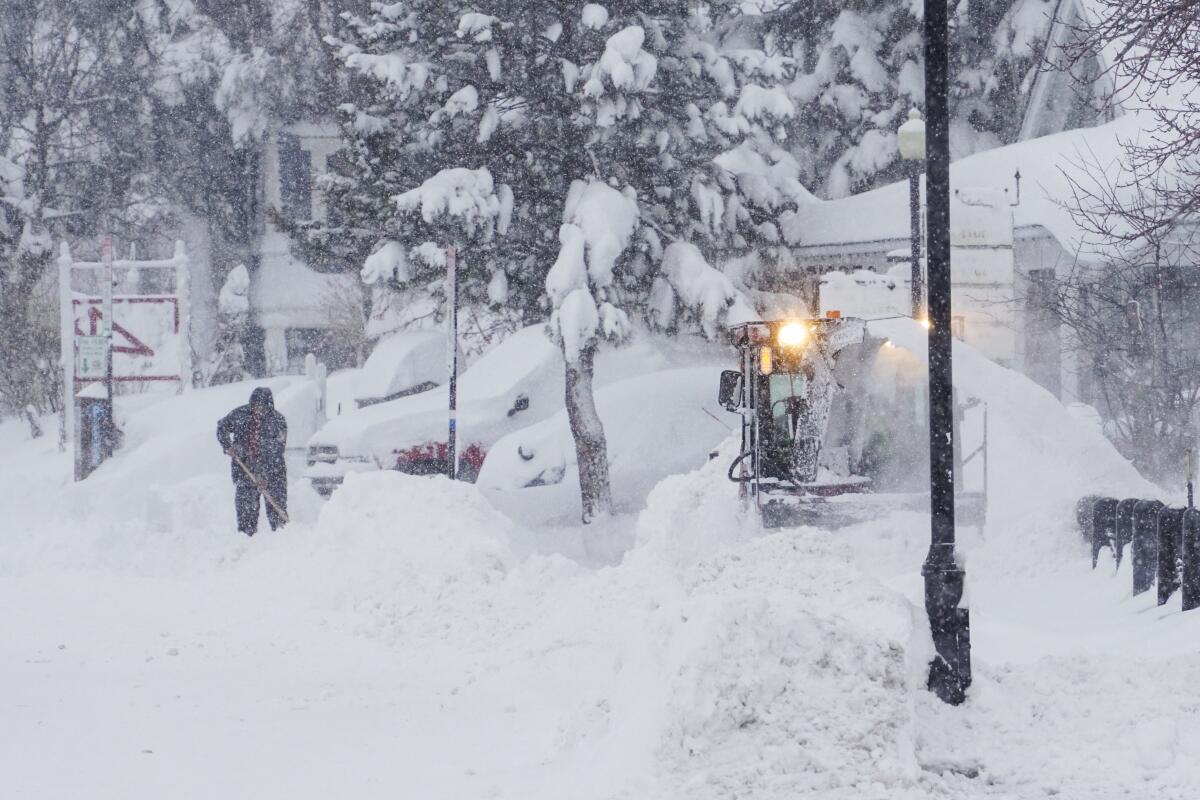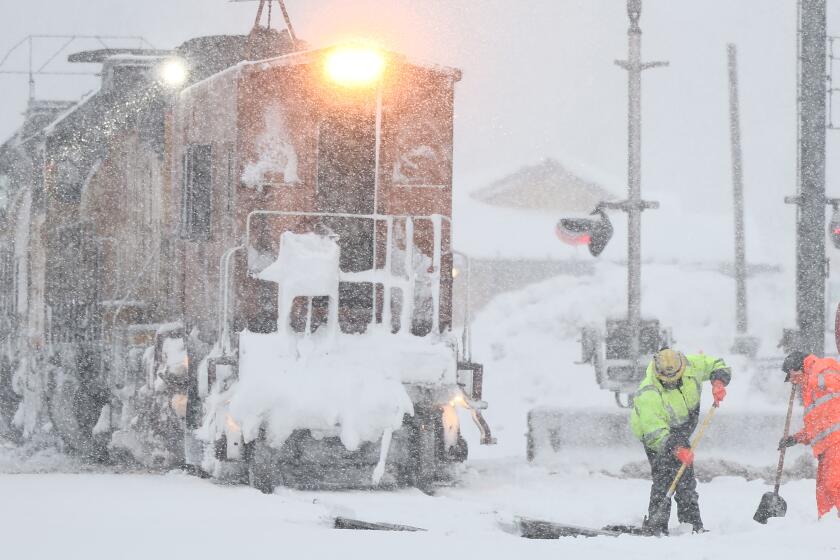Monster blizzard shatters California ‘snow drought’ with up to 10 feet of new snow

- Share via
A monster blizzard that blasted California’s Sierra Nevada with gusts of up to 190 mph and dumped more than 10 feet of snow over the weekend shattered the state’s “snow drought” and significantly boosted vital snowpack levels.
The statewide snowpack by Monday had swelled to 104% of normal for the date, with a snow water equivalent of 24.4 inches. Snowpack was about 94% of its average for April 1, the date when it is typically at its deepest.
On Thursday — hours before the chilly winter storm was set to hit — the snowpack had measured only 80% of normal. It was an impressive turnaround compared with the beginning of the year when the snowpack was 32% of normal.
Officials were optimistic the blizzard would offer a significant snow boost. It ended up being a game-changer.
“It takes us effectively from needing about 25% of our snowpack to get up to a good water year to being within about 6%, which is absolutely fantastic,” said Andrew Schwartz, a lead scientist at the UC Berkeley Central Sierra Snow Lab. “We’re exactly where we want to be, realistically.”
Storms in February have significantly boosted California’s snowpack, giving the state near-average conditions and ample water supplies.
But state water officials note there still needs to be more snow for California to end the water year at average.
“This storm did not push us all the way to the April 1 average,” state climatologist Michael Anderson said in a statement. The southern Sierra is still behind average for this time of year.
“March will remain a critical month to see how we will finish out the season. We may still need some additional storms to boost our snowpack above average by April 1 and improve our chances of having average runoff into our reservoirs,” Anderson said.
Demetri Polyzos, a water supply manager for the Metropolitan Water District of Southern California, said he thought the Sierra blizzard would significantly improve Southern California’s water supply. He thinks the district will see an increase in its allocation of water supplies from Northern California.
“These storms definitely will improve our water supply situation, for sure, this year,” Polyzos said.
Photos of a blizzard that is burying the Sierra Nevada in California in blankets of snow.
The weekend storm, which originated in the Gulf of Alaska and picked up significant moisture over the northern Pacific Ocean, was the strongest of the winter season in terms of snow and left some impressive totals at Sierra ski resorts.
Over the four-day blizzard, Sugar Bowl recorded 10.5 feet of snow, and at Soda Springs — about 14 miles west of Truckee — 9.7 feet of snow fell. At nearby Kingvale, 8.8 feet of snow dropped.
“They’ve been pretty phenomenal,” meteorologist Amanda Young of the National Weather Service’s Reno office said of the snowfall totals. Over the weekend, Sugar Bowl published a video of accumulated, wind-blown snowfall blocking most of a doorway.
Mammoth Mountain saw up to 4 feet of snow in higher elevations with 2 to 3 inches falling in the last 24 hours, the ski resort reported on social media. The resort was forced to close Sunday after being battered by winds of up to 70 mph. It was beginning to reopen chairlifts Monday but was still reporting delays because of strong winds.
More than 8 feet of snow fell on the Palisades Tahoe resort, which also battled 180-mph winds that blew out windows on its upper terminal, filling it with snow and stymieing operations.
“Though there were some doubts on Thursday whether or not we were going to get the storm of the season, the weather forecast proved to be accurate,” Liz Worgan, an employee at the Palisades Tahoe resort, wrote on its website.
Heavenly Mountain Resort in South Lake Tahoe had received nearly 5 feet of snow by Monday. The gondola and upper mountain chairlifts were all closed over the weekend because of wind, but the lower sections of the mountain remained open.
“That gave us a little bit of a head start today,” said Tom Fortune, the resort’s vice president and chief operating officer. “It certainly made some people happy who like to ski in blizzards.”
There’s a 25% chance of 3 to 5 inches of additional snow falling along Donner Pass on Monday and as much as 6 inches at higher peaks. On the western shore of Lake Tahoe, there’s a slightly lower chance of about an inch of snow Monday.
Snow showers are expected to linger over the northern Sierra on Monday, and there will be additional possibilities of snow Tuesday and Wednesday. Later this week looks to be drier, but it’s possible there could be more mountain snow showers this weekend, according to the weather service.
Fortune said “an army of people” were on the mountain Monday morning working to dig out ski lifts and lodges in hopes the higher elevations can reopen in the coming days.
“It’s just a beautiful white blanket,” Fortune said of conditions. “This is what we live for. The snow we’ve gotten is really going to be a game-changer for the rest of the season.”
The California snowstorm cut off Mammoth Mountain from SoCal again Sunday and paralyzed Interstate 80. A blizzard warning was extended for Mammoth until Sunday night and the Tahoe area through Monday morning.
The blizzard also caused its share of headaches.
The massive storm shuttered Highway 395 from Southern California to Mammoth Mountain and Interstate 80 to the northern Lake Tahoe area for much of the weekend because of whiteout conditions.
The California Department of Transportation on Monday was able to reopen a key stretch of Highway 395 between Mammoth and northwest of Bishop. However, a 50-mile stretch of the highway remains closed north of Mammoth Mountain — all the way to Bridgeport — meaning road access to the ski resort from Reno remains closed. Caltrans crews were still clearing snow and abandoned cars off the roadway Monday.
Interstate 80 — the route to the northern Tahoe area — also reopened to passenger traffic, but California Highway Patrol officials warned the road was snow-covered and icy.
Over the weekend, crews spent several hours rescuing trapped motorists whose vehicles were stuck in the snow on Interstate 80. Emergency personnel and tow trucks had a difficult time getting to drivers. Caltrans has also faced difficulty as snow blowers have broken down under extreme weather conditions.
But for outdoor enthusiasts and state water managers, the storm was a welcome gift from Mother Nature.
California’s wet season started slow, with little precipitation in November and December. Storm systems picked up in January and February, but most were warmer than usual — delivering more rain than snow — and frequently fell in the southern part of the state. The slow start resulted in some uncertainty about water supplies given that the snowpack typically accounts for about a third of the state’s supply in a given year.
More to Read
Sign up for Essential California
The most important California stories and recommendations in your inbox every morning.
You may occasionally receive promotional content from the Los Angeles Times.















